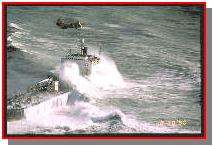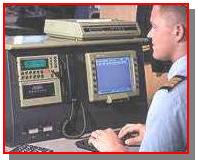Since the invention of radio at the end of the 19th Century, ships at sea have relied on Morse code, invented by Samuel Morse and first used in 1844, for distress and safety telecommunications. The need for ship and coast radio stations to have and use radiotelegraph equipment, and to listen to a common radio frequency for Morse encoded distress calls, was recognised after the sinking of the liner Titanic in the North Atlantic in 1912. The U.S. Congress enacted legislation soon after, requiring U.S. ships to use Morse code radiotelegraph equipment for distress calls. The International Telecommunications Union (ITU), now a United Nations agency, followed suit for ships of all nations. Morse encoded distress calling has saved thousands of lives since its inception almost a century ago, but its use requires skilled radio operators spending many hours listening to the radio distress frequency. Its range on the medium frequency (MF) distress band (500 kHz) is limited, and the amount of traffic Morse signals can carry is also limited.

Over fifteen years ago the International Maritime Organisation (IMO), a United Nations agency specialising in safety of shipping and preventing ships from polluting the seas, began looking at ways of improving maritime distress and safety communications. In 1979, a group of experts drafted the International Convention on Maritime Search and Rescue, which called for development of a global search and rescue plan. This group also passed a resolution calling for development by IMO of a Global Maritime Distress and Safety System (GMDSS) to provide the communication support needed to implement the search and rescue plan. This new system, which the world's maritime nations, including the United States, are implementing, is based upon a combination of satellite and terrestrial radio services, and has changed international distress communications from being primarily ship-to-ship based to ship-to-shore (Rescue Co-ordination Center) based. It spelled the end of Morse code communications for all but a few users, such a s Amateur Radio. The GMDSS provides for automatic distress alerting and locating in cases where a radio operator doesn't have time to send an SOS or MAYDAY call, and, for the first time, requires ships to receive broadcasts of maritime safety information which could prevent a distress from happening in the first place. In 1988, IMO amended the Safety of Life at Sea (SOLAS) Convention, requiring ships subject to it fit GMDSS equipment. Such ships were required to carry NAVTEX and satellite EPIRBs by 1 August 1993, and had to fit all other GMDSS equipment by 1 February 1999. US ships were allowed to fit GMDSS in lieu of Morse telegraphy equipment by the Telecommunications Act of 1996.

The GMDSS consists of several systems, some of which are new, but many of which have been in operation for many years. The system will be able to reliably perform the following functions: alerting (including position determination of the unit in distress), search and rescue co-ordination, locating (homing), maritime safety information broadcasts, general communications, and bridge-to-bridge communications. Specific radio carriage requirements depend upon the ship's area of operation, rather than its tonnage. The system also provides redundant means of distress alerting, and emergency sources of power.
The GMDSS consists of many separate systems which are being implemented in a co-ordinated and agreed-upon manner. Some of these systems are discussed below:
Ships subject to the Chapter IV of the Safety of Life at Sea (SOLAS) Convention have to fit GMDSS equipment. These include all ships engaged on international voyages except:
Ships subject to Title II Part II and Part III of the Communications Act of 1934, as amended have to fit GMDSS equipment under FCC Regulation 47 CFR 80 Subpart W. These include all ships, including fishing vessels, to be navigated in the open sea outside of a harbour or port, except:
Note that on 20 November 1998, the FCC has waived certain GMDSS rules applicable to fishing vessels and small passenger vessels.
Mobile Offshore Drilling Units have to fit GMDSS equipment if they are self propelled, or if they are required to meet the International Maritime Organisation's MODU Code.